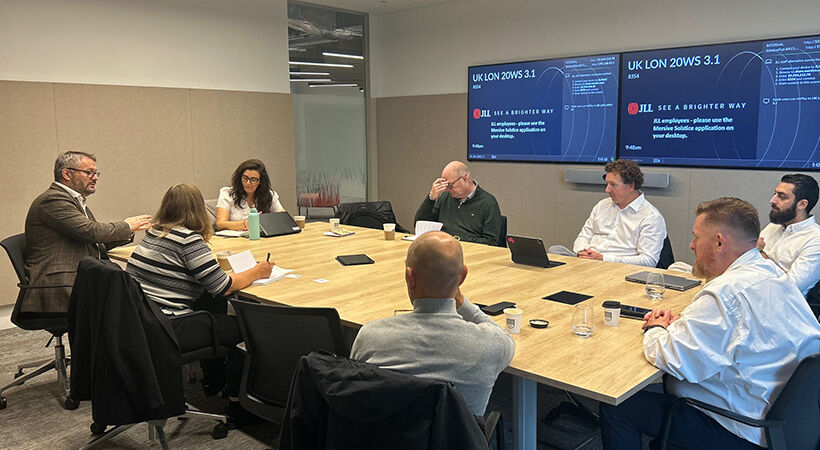In a wide ranging discussion, hosted by JLL, there was a deep dive into the progress of building digitalisation from the perspective of building owners, operators and facility managers.
Attendees
Allan Fourie, technology lead – property management, JLL Technologies
Ross Powell, account director, property management technology Europe, JLL Technologies
Magnus Leask, director, HoareLea
Joanna Harris, head of technical services, Sodexo
Siobhan Riordan, global head of sustainability (on account), JLL
Petr Lochman, senior facilities manager and hard services lead, Derwent
Tom Michael, UK digital building team leader, NDY
The outcome as ever was of a mixed picture of where the market is and how artificial intelligence (AI) is or is not driving the industry.
Ross opened by saying that JLL has been on this technology journey for over 10 years. Ross, who is from a management accounting side of property management saw that transactions were still being done with an actual paper trail 10 years ago. This was transformed to an e-signing model which immediately let managers know how much was waiting to go out of bank accounts . From this Ross realised that he was working in an absolutely massive industry of cottage solutions. Ross therefore doesn’t see many people with a coherent portfolio strategy, He sees building level strategies. At the moment we're going to deal with this building by building today, as opposed to a common standard.
Petr then commented that Derwent’s portfolio of 60 buildings in central London, has new buildings, and ones that are 30 or 40 years old. So it's very hard to have one strategy for both type of buildings. because you cannot do much with 40 year old systems. and the classic building from the ‘80s is very limited what you can do without big capital spending. So we have portfolio strategy where we want to go net zero and but how do we get there? The company has to go building by building. The main challenge is what to do with the old buildings.
This led on to the fact that a global strategy is virtually impossible to implement due to legacy systems, different models and practices in different countries and how the market works in each territory. It was also pointed out many landlords put their smart building costs into the tenant service charges and this will be what is under pressure in the coming years.
Magnus pointed out that not all strategies can be used from the same template but standardisation across portfolios would help managers immensely.
It was also pointed out that there is always a tendency to use the cheapest tools in the industry not the best. Tom pointed out that most decisions need an internal champion in order to get the best possible outcome with Siobhan adding that there are so many BMS systems that it is a very difficult process to come up with a solution that pleases everybody.
This issue of standardisation across the estate, brought in the question of whether AI can be used to solve problems the same problems that occur over the estate. This again hit home that the problem occurs when there are different generations of buildings with legacy technology inside that will not be changed due to the large amount of capital expenditure that it would take to replace ‘invisible’ technology like HVAC and the resulting BMS software.
Joanna and Petr pointed out that this is a major issue for companies such as Sodexo and Derwent.
Another issue is the business case for technology. One example was putting £150k worth of cost onto a service charge in the hope of saving £20k, which is clearly not sustainable. What all around the table agreed is that you need good data for AI to take off and the industry is not good at sharing data (often due to sensitivity issues) and also not good at using the data to solve problems. Also storing the data is an issue as companies with global portfolios have to store their data in different ways and cannot even share the data internally due to different countries laws. Also, the software solutions are not cheap and it is a very difficult decision for a facilities manager to make.
It was also highlighted that lots of decisions made are very short term. An example is switched reluctance motors which reduce your costs massively compare to traditional induction motors and over the next 10 years, you wouldn't be replacing any motors once you put these in. However a financial decision needs to be made by someone who understands the engineering (as is in Derwent’s case who already completed one project using this innovative technology). However, this is not normally the case and cheaper motors are installed, which will need to be replaced and cost more in the long term.
Ross commented that every time he talks about AI, he asks who works in your organisation who's involved in implementation? He wants to see people who've done the job, understand it, whether it's financial, M&E or procurement and had a number of years' experience in interacting involved in the development of the product, and can describe the usecases in a useful and detailed way. That's when he feels an AI product has got legs. He commented “I see it in student housing. I see it in residential management. I see it in M&E and engineering solutions, where a lot of of the time what the AI doing is basically trained by someone who should be delivering the outcome. And the AI just comes in and delivers impact. I see in financial management, analysis and insight, a huge amount of AI will be used in near future.”
Alan concluded, “What did not came as a surprise was the fact we’re all dealing with the same issues and face the same obstacles.”





